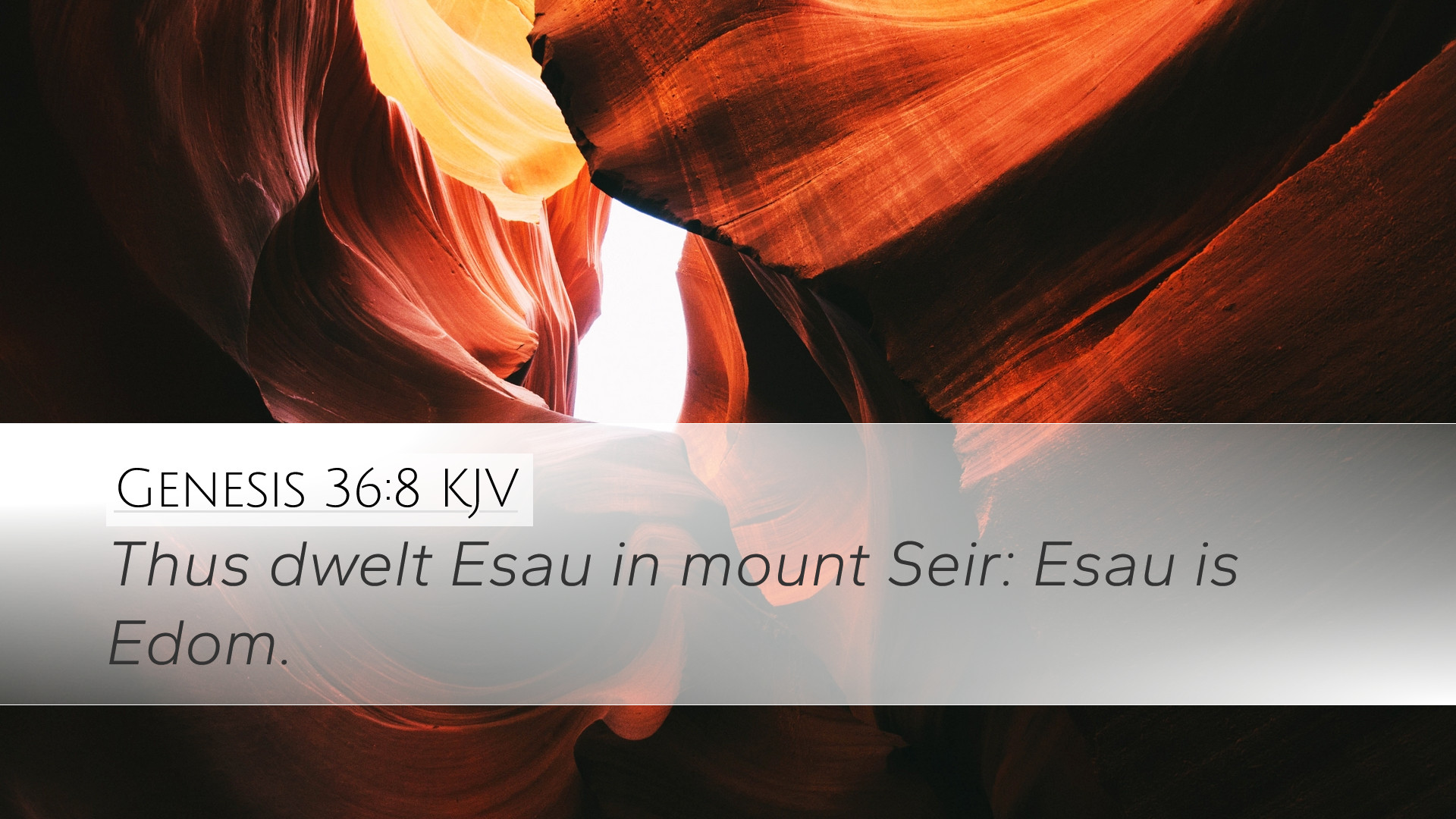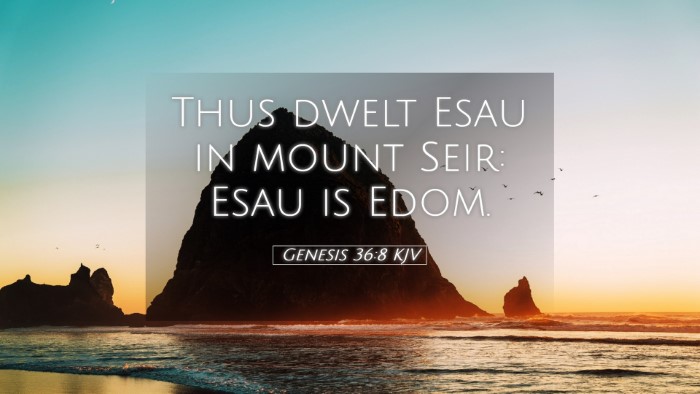Commentary on Genesis 36:8
Verse: Genesis 36:8 - "Thus dwelt Esau in mount Seir: Esau is Edom."
Introduction
Genesis 36:8 serves as a pivotal verse in the narrative of Esau and his descendants. This verse succinctly encapsulates both geographical and genealogical information about Esau, who is intimately connected with the nation of Edom. Understanding the significance of this verse requires a careful examination of the context in which it is placed, as well as its implications in biblical history.
Historical Context
The relationship between Esau and Jacob, his brother, sets the foundational narrative for the themes of rivalry, conflict, and reconciliation throughout Genesis. As the descendants of Isaac, both Esau and Jacob represent two distinct paths within the Abrahamic lineage, affecting the socio-political landscape of the surrounding regions.
Esau's Identity
The statement "Esau is Edom" emphasizes Esau's identity and his transformation into the progenitor of a significant nation. The name "Edom," derived from the Hebrew word for "red," connects back to the birth narrative when Esau emerged from the womb. This identity was pivotal in shaping the narrative of the Edomites, influencing their future interactions with Israel.
Theological Significance
This verse can be viewed through various theological lenses that highlight God’s providential oversight and the unfolding of His redemptive plan:
- Divine Sovereignty: The separation of Jacob and Esau and the establishment of distinct nations illustrates God's control over human affairs for the greater purpose of His covenant promises.
- Fulfillment of Prophecy: God's prophecy to Rebekah indicating that "the older shall serve the younger" (Genesis 25:23) finds its early realization as the Edomites emerge in opposition to Israel.
- Nature of Human Relationships: The ongoing enmity between the descendants of Esau (Edomites) and Israel serves as a profound illustration of the complexities of human relationships under God’s design.
Geographical Implications
Mount Seir's geographical significance cannot be ignored. This rugged mountainous territory, located southeast of the Dead Sea, became synonymous with the Edomite people:
- Settlement Patterns: The reference to Esau's dwelling in "mount Seir" illustrates the Edomites' adaptation to their environment, as they navigated the harsh landscape to establish their community.
- Historical Conflicts: The location was strategically important, leading to numerous conflicts between the Edomites and the Israelites, as seen in the subsequent narratives of Exodus and the historical books of the Old Testament.
Commentaries from Public Domain Authors
Matthew Henry
Matthew Henry comments on the significance of Esau's settlement, noting that it reflects the providence of God in directing the paths of individuals and nations. Henry highlights that Esau, despite his contentious relationship with Jacob, finds his identity and place in history, demonstrating God’s use of imperfect people to fulfill His plans.
Albert Barnes
In his commentary, Albert Barnes elaborates on the importance of the phrase "Esau is Edom," asserting that it establishes a national identity that would later play a significant role in biblical narrative. Barnes points out that the Edomites, though descended from Isaac, often found themselves at odds with the children of Jacob, thus fulfilling the prophetic pronouncement concerning their future.
Adam Clarke
Adam Clarke provides an insightful analysis of the cultural and historical ramifications of Esau's lineage. He explains that Edom, as a nation, would have a lasting impact on Israel and their history, often serving as a foil against which Israel is contrasted. Clarke emphasizes the importance of understanding this complexity to grasp the full scope of Israel's struggles and triumphs.
Lessons for Today's Readers
For pastors, students, theologians, and scholars, Genesis 36:8 offers essential lessons in understanding both the human condition and divine orchestration in history:
- Identity in Christ: Just as Esau is identified through his descendants, believers are called to find their identity in Christ, reminding us that we are part of a larger story.
- God's Sovereign Plan: The unfolding of the Edomite narrative encourages us to trust in God's sovereign plan, even when circumstances appear tumultuous.
- Understanding Human Relationships: The relations between Esau, Jacob, and their descendants prompt reflection on our own community dynamics and how God might work through our relationships for His glory.
Conclusion
Genesis 36:8 stands as a monument of God's providence and the complexity of human relationships. As Esau takes residence in mount Seir, it not only marks the birth of a nation but also serves as a lighthouse illuminating themes of identity, conflict, and divine purposes in history. This verse, while brief, encapsulates rich layers of meaning and reflection for all who seek to understand the Scriptures deeply. In the historical narrative, the significance of Esau’s legacy continues to reverberate through the stories of the Bible and their implications for the church today.


